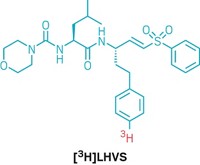Advertisement
Grab your lab coat. Let's get started
Welcome!
Welcome!
Create an account below to get 6 C&EN articles per month, receive newsletters and more - all free.
It seems this is your first time logging in online. Please enter the following information to continue.
As an ACS member you automatically get access to this site. All we need is few more details to create your reading experience.
Not you? Sign in with a different account.
Not you? Sign in with a different account.
ERROR 1
ERROR 1
ERROR 2
ERROR 2
ERROR 2
ERROR 2
ERROR 2
Password and Confirm password must match.
If you have an ACS member number, please enter it here so we can link this account to your membership. (optional)
ERROR 2
ACS values your privacy. By submitting your information, you are gaining access to C&EN and subscribing to our weekly newsletter. We use the information you provide to make your reading experience better, and we will never sell your data to third party members.
Radiochemistry
Tritiation reaction takes a new tack
Isotopic label added to complex molecules with an assist from aryl thianthrenium salts
by Bethany Halford
December 14, 2021
To study how drugs and drug candidates behave in biological systems, scientists often replace a hydrogen atom in a compound of interest with an atom of the isotope tritium, which acts a radioactive beacon. Chemists led by Tobias Ritter at the Max Plank Institute for Coal Research report a new tritium-installation method that sidesteps challenges associated with other methods for tritiation (Nature 2021, DOI: 10.1038/s41586-021-04007-y).

The reaction capitalizes on the reactivity of thianthrenium salts, which Ritter’s team reported in 2019. Chemists can selectively place thianthrenium salts in the para position of aromatic groups. The thianthrenium group can then be replaced with tritium via hydrogenolysis using a homogeneous palladium catalyst and tritium gas. Although chemists have previously used hydrogenolysis to place tritium in molecules, they typically relied on heterogeneous catalysts, such as palladium on a carbon support, to do so. Heterogeneous catalysts tend to be less selective than homogeneous catalysts in hydrogenolysis reactions, and can react with other groups such as halides or nitriles on complex molecules.
Ritter’s team used the reaction to tack tritium onto several complex molecules, including the antiparasitic compound LHVS (shown). The new tritiation reaction doesn’t require an inert atmosphere or dry conditions, which makes it easy to execute, the chemists say.




Join the conversation
Contact the reporter
Submit a Letter to the Editor for publication
Engage with us on Twitter